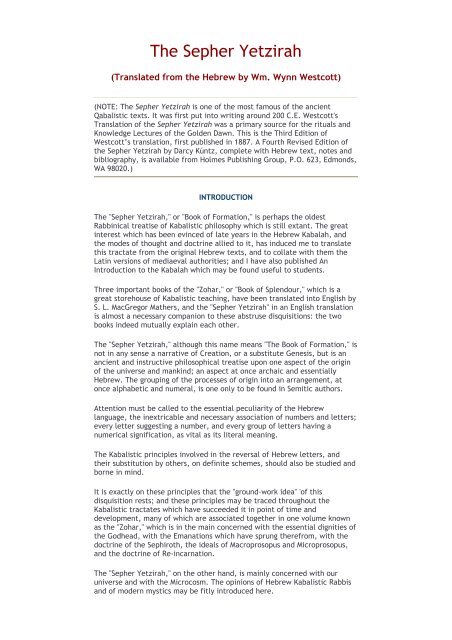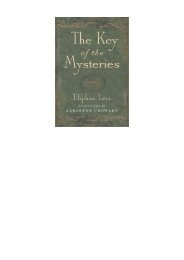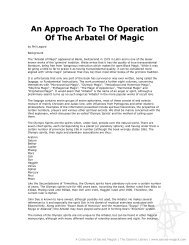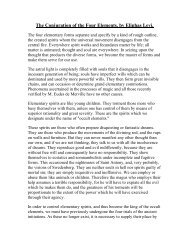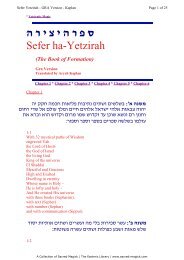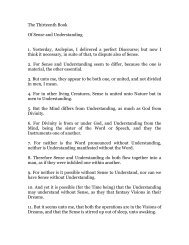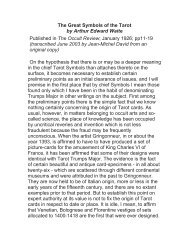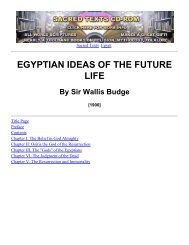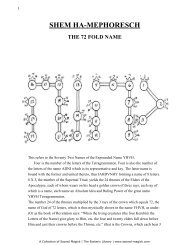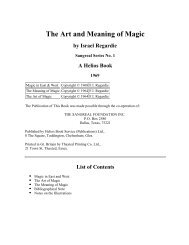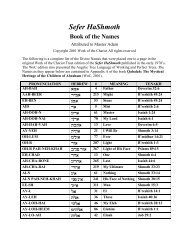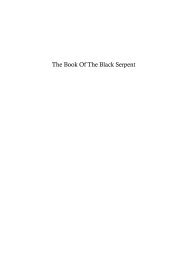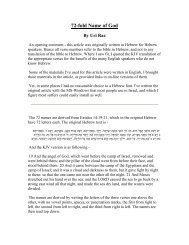The Sepher Yetzirah
The Sepher Yetzirah
The Sepher Yetzirah
Create successful ePaper yourself
Turn your PDF publications into a flip-book with our unique Google optimized e-Paper software.
<strong>The</strong> <strong>Sepher</strong> <strong>Yetzirah</strong><br />
(Translated from the Hebrew by Wm. Wynn Westcott)<br />
(NOTE: <strong>The</strong> <strong>Sepher</strong> <strong>Yetzirah</strong> is one of the most famous of the ancient<br />
Qabalistic texts. It was first put into writing around 200 C.E. Westcott's<br />
Translation of the <strong>Sepher</strong> <strong>Yetzirah</strong> was a primary source for the rituals and<br />
Knowledge Lectures of the Golden Dawn. This is the Third Edition of<br />
Westcott’s translation, first published in 1887. A Fourth Revised Edition of<br />
the <strong>Sepher</strong> <strong>Yetzirah</strong> by Darcy Kúntz, complete with Hebrew text, notes and<br />
bibliography, is available from Holmes Publishing Group, P.O. 623, Edmonds,<br />
WA 98020.)<br />
INTRODUCTION<br />
<strong>The</strong> "<strong>Sepher</strong> <strong>Yetzirah</strong>," or "Book of Formation," is perhaps the oldest<br />
Rabbinical treatise of Kabalistic philosophy which is still extant. <strong>The</strong> great<br />
interest which has been evinced of late years in the Hebrew Kabalah, and<br />
the modes of thought and doctrine allied to it, has induced me to translate<br />
this tractate from the original Hebrew texts, and to collate with them the<br />
Latin versions of mediaeval authorities; and I have also published An<br />
Introduction to the Kabalah which may be found useful to students.<br />
Three important books of the "Zohar," or "Book of Splendour," which is a<br />
great storehouse of Kabalistic teaching, have been translated into English by<br />
S. L. MacGregor Mathers, and the "<strong>Sepher</strong> <strong>Yetzirah</strong>" in an English translation<br />
is almost a necessary companion to these abstruse disquisitions: the two<br />
books indeed mutually explain each other.<br />
<strong>The</strong> "<strong>Sepher</strong> <strong>Yetzirah</strong>," although this name means "<strong>The</strong> Book of Formation," is<br />
not in any sense a narrative of Creation, or a substitute Genesis, but is an<br />
ancient and instructive philosophical treatise upon one aspect of the origin<br />
of the universe and mankind; an aspect at once archaic and essentially<br />
Hebrew. <strong>The</strong> grouping of the processes of origin into an arrangement, at<br />
once alphabetic and numeral, is one only to be found in Semitic authors.<br />
Attention must be called to the essential peculiarity of the Hebrew<br />
language, the inextricable and necessary association of numbers and letters;<br />
every letter suggesting a number, and every group of letters having a<br />
numerical signification, as vital as its literal meaning.<br />
<strong>The</strong> Kabalistic principles involved in the reversal of Hebrew letters, and<br />
their substitution by others, on definite schemes, should also be studied and<br />
borne in mind.<br />
It is exactly on these principles that the "ground-work idea" 'of this<br />
disquisition rests; and these principles may be traced throughout the<br />
Kabalistic tractates which have succeeded it in point of time and<br />
development, many of which are associated together in one volume known<br />
as the "Zohar," which is in the main concerned with the essential dignities of<br />
the Godhead, with the Emanations which have sprung therefrom, with the<br />
doctrine of the Sephiroth, the ideals of Macroprosopus and Microprosopus,<br />
and the doctrine of Re-incarnation.<br />
<strong>The</strong> "<strong>Sepher</strong> <strong>Yetzirah</strong>," on the other hand, is mainly concerned with our<br />
universe and with the Microcosm. <strong>The</strong> opinions of Hebrew Kabalistic Rabbis<br />
and of modern mystics may be fitly introduced here.
<strong>The</strong> following interesting quotation is from Rabbi Moses Botarel, who wrote<br />
his famous Commentary in 1409:--"It was Abraham our Father--blessed be<br />
he--who wrote this book to condemn the doctrine of the sages of his time,<br />
who were incredulous of the supreme dogma of the Unity. At least, this was<br />
the opinion of Rabbi Saadiah--blessed be he--as written in the first chapter<br />
of his book <strong>The</strong> Philosopher's Stone. <strong>The</strong>se are his words: <strong>The</strong> sages of<br />
Babylon attacked Abraham on account of his faith; for they were all against<br />
him although themselves separable into three sects. <strong>The</strong> First thought that<br />
the Universe was subject to the control of two opposing forces, the one<br />
existing but to destroy the other, this is dualism; they held that there was<br />
nothing in common between the author of evil and the author of good. <strong>The</strong><br />
Second sect admitted Three great Powers; two of them as in the first case,<br />
and a third Power whose function was to decide between the two others, a<br />
supreme arbitrator. <strong>The</strong> Third sect recognised no god beside the Sun, in<br />
which it recognised the sole principle of existence."<br />
Rabbi Judah Ha Lévi (who flourished about 1120), in his critical description<br />
of this treatise, wrote: "<strong>The</strong> <strong>Sepher</strong> <strong>Yetzirah</strong> teaches us the existence of a<br />
Single Divine Power by shewing us that in the bosom of variety and<br />
multiplicity there is a Unity and Harmony, and that such universal concord<br />
could only arise from the rule of a Supreme Unity."<br />
According to Isaac Myer, in his Quabbalah (p. 159), the "<strong>Sepher</strong> <strong>Yetzirah</strong>" was<br />
referred to in the writings of Ibn Gebirol of Cordova, commonly called<br />
Avicebron, who died in A.D. 1070.<br />
Eliphas Levi, the famous French Occultist, thus wrote of the "<strong>Sepher</strong><br />
<strong>Yetzirah</strong>," in his Histoire de la Magie, p. 54: "<strong>The</strong> Zohar is a Genesis of<br />
illumination, the <strong>Sepher</strong> Jezirah is a ladder formed of truths. <strong>The</strong>rein are<br />
explained the thirty-two absolute signs of sounds, numbers and letters: each<br />
letter reproduces a number, an idea and a form; so that mathematics are<br />
capable of application to ideas and to forms not less rigorously than to<br />
numbers, by exact proportion and perfect correspondence. By the science of<br />
the <strong>Sepher</strong> Jezirah the human spirit is fixed to truth, and in reason, and is<br />
able to take account of the possible development of intelligence by the<br />
evolutions of numbers. <strong>The</strong> Zohar represents absolute truth, and the <strong>Sepher</strong><br />
Jezirah provides the means by which we may seize, appropriate and make<br />
use of it."<br />
Upon another page Eliphas Lévi writes: "<strong>The</strong> <strong>Sepher</strong> Jezirah and the<br />
Apocalypse are the masterpieces of Occultism; they contain more wisdom<br />
than words; their expression is as figurative as poetry, and at the same time<br />
it is as exact as mathematics.<br />
In the volume entitled La Kabbale by the eminent French scholar, Adolphe<br />
Franck, there is a chapter on the "<strong>Sepher</strong> <strong>Yetzirah</strong>." He writes as follows:--<br />
"<strong>The</strong> Book of Formation contains, I will not say system of physics, but of<br />
cosmology such as could be conceived at an age and in a country where the<br />
habit of explaining all phenomena by the immediate action of the First<br />
Cause, tended to check the spirit of observation, and where in consequence<br />
certain general and superficial relations perceived in the natural world<br />
passed for the science of Nature."…"Its form is simple and grave; there is<br />
nothing like a demonstration nor an argument; but it consists rather of a<br />
series of aphorisms, regularly grouped, and which have all the conciseness of<br />
the most ancient oracles."<br />
In his analysis of the "<strong>Sepher</strong> <strong>Yetzirah</strong>," he adds:--"<strong>The</strong> Book of Formation,<br />
even if it be not very voluminous, and if it do not altogether raise us to very<br />
elevated regions of thought, yet offers us at least a composition which is<br />
very homogeneous and of a rare originality. <strong>The</strong> clouds which the
imagination of commentators have gathered around it, will be dissipated, if<br />
we look for, in it, not mysteries of ineffable wisdom, but an attempt at a<br />
reasonable doctrine, made when reason arose, an effort to grasp the plan of<br />
the universe, and to secure the link which binds to one common principle,<br />
all the elements which are around us."<br />
"<strong>The</strong> last word of this system is the substitution of the absolute divine Unity<br />
for every idea of Dualism, for that pagan philosophy which saw in matter an<br />
eternal substance whose laws were not in accord with Divine Will; and for<br />
the Biblical doctrine, which by its idea of Creation, postulates two things,<br />
the Universe and God, as two substances absolutely distinct one from the<br />
other.<br />
"In fact, in the '<strong>Sepher</strong> <strong>Yetzirah</strong>,' God considered as the Infinite and<br />
consequently the indefinable Being, extended throughout all things by his<br />
power and existence, is while above, yet not outside of numbers, sounds and<br />
letters--the principles and general laws which we recognise."<br />
"Every element has its source from a higher form, and all things have their<br />
common origin from the Word (Logos), the Holy Spirit…. So God is at once,<br />
in the highest sense, both the matter and the form of the universe. Yet He is<br />
not only that form; for nothing can or does exist outside of Himself; His<br />
substance is the foundation of all, and all things bear His imprint and are<br />
symbols of His intelligence."<br />
Hebrew tradition assigns the doctrines of the oldest portions of the "Zohar"<br />
to a date antecedent to the building of the Second Temple, but Rabbi<br />
Simeon ben Jochai, who lived in the reign of the Emperor Titus, A.D. 70-80,<br />
is considered to have been the first to commit these to writing, and Rabbi<br />
Moses de Leon, of Guadalaxara, in Spain, who died in 1305, certainly<br />
reproduced and published the "Zohar."<br />
Ginsburg, speaking of the Zoharic doctrines of the Ain Suph, says that they<br />
were unknown until the thirteenth century, but he does not deny the great<br />
antiquity of the "<strong>Sepher</strong> <strong>Yetzirah</strong>," in which it will be noticed the "Ain Suph<br />
Aur" and "Ain Suph" are not mentioned.I suggest, however, that this omission<br />
is no proof that the doctrines of "Ain Suph Aur" and "Ain Suph" did not then<br />
exist, because it is a reasonable supposition that the "<strong>Sepher</strong> <strong>Yetzirah</strong>" was<br />
the volume assigned to the Yetziratic World, the third of the four Kabalistic<br />
Worlds of Emanation, while the "Asch Metzareph" is concerned with the<br />
Assiatic, fourth, or lowest World of Shells, and is on the face of it an<br />
alchemical treatise; and again the "Siphra Dtzenioutha" may be fittingly<br />
considered to be an Aziluthic work, treating of the Emanations of Deity<br />
alone; and there was doubtless a fourth work assigned to the World of Briah-<br />
-the second type, but I have not been able to identify this treatise. Both the<br />
Babylonian and the Jerusalem Talmuds refer to the "<strong>Sepher</strong> <strong>Yetzirah</strong>." <strong>The</strong>ir<br />
treatise, named "Sanhedrin," certainly mentions the "Book of Formation,"<br />
and another similar work; and Rashi in his commentary on the treatise<br />
"Erubin," considers this a reliable historical notice.Other historical notices<br />
are those of Saadya Gaon, who died A.D. 940, and Judah Ha Levi, A.D. 1150;<br />
both these Hebrew classics speak of it as a very ancient work. Some modern<br />
critics have attributed the authorship to the Rabbi Akiba, who lived in the<br />
time of the Emperor Hadrian, A.D. 120, and lost his life in supporting the<br />
claims of Barchocheba, a false messiah: others suggest it was first written<br />
about A.D. 200.<br />
Graetz however assigns it to early Gnostic times, third or fourth century,<br />
and Zunz speaks of it as post Talmudical, and belonging to the Geonim<br />
period 700-800 A.D.; Rubinsohn, in the Bibliotheca Sacra, speaks of this<br />
latter idea as having no real basis.
<strong>The</strong> Talmuds were first collected into a concrete whole, and printed in<br />
Venice, 1520 A.D.<br />
<strong>The</strong> "Zohar" was first printed in Mantua in 1558; again in Cremona, 1560; and<br />
at Lublin, 1623; and a fourth edition by Knorr von Rosenroth, at Sulzbach in<br />
1684. Some parts are not very ancient, because the Crusades are mentioned<br />
in one chapter. Six extant Hebrew editions of the "<strong>Sepher</strong> <strong>Yetzirah</strong>" were<br />
collected and printed at Lemberg in 1680. <strong>The</strong> oldest of these six recensions<br />
was that of Saadjah Gaon (by some critics called spurious).<strong>The</strong>re are still<br />
extant three Latin versions, viz., that of Gulielmus Postellus; one by Johann<br />
Pistorius; and a third by Joannes Stephanus Rittangelius; this latter gives<br />
both Hebrew and Latin versions, and also "<strong>The</strong> Thirty-Two Paths" as a<br />
supplement.<br />
<strong>The</strong>re is a German translation, by Johann Friedrich von Meyer, dated 1830; a<br />
version by Isidor Kalisch, in which he has reproduced many of the valuable<br />
annotations of Meyer; an edition in French by Papus, 1888; an edition in<br />
French by Mayer Lambert, 1891, with the Arabic Commentary of Saadya<br />
Gaon; and an English edition by Peter Davidson, 1896, to which are added<br />
"<strong>The</strong> Fifty Gates of Intelligence" and "<strong>The</strong> Thirty-Two Ways of Wisdom." <strong>The</strong><br />
edition which I now offer is fundamentally that of the ancient Hebrew<br />
codices translated into English, and collated with the Latin versions of<br />
Pistorius, Postellus, and Rittangelius, following the latter, rather than the<br />
former commentators. As to the authenticity of "<strong>The</strong> <strong>Sepher</strong> <strong>Yetzirah</strong>,"<br />
students may refer to the Bibliotheca magna Rabbinica of Bartoloccio de<br />
Cellerio, Rome, 1678-1692; to Basnage, History of the Jews, 1708; and to<br />
<strong>The</strong> Doctrine and Literature of the Kabalah, by A. B. Waite, 1902.<strong>The</strong><br />
following copies of the "<strong>Sepher</strong> <strong>Yetzirah</strong>" in Hebrew, I have also examined,<br />
but only in a superficial manner:--<br />
1. A Version by Saadiah, Ab. ben David, and three others, Mantua, 1562, 4to.<br />
2. A Version with the commentary of Rabbi Abraham F. Dior, Amsterdam,<br />
1642, 4to.<br />
3. A Version with preface by M. ben J. Chagiz, Amsterdam, 1713, 16mo.4. A<br />
Version, Constantinople, 1719, 8vo.<br />
5. " " Zolkiew, 1745, 4to.<br />
6. " " by Moses ben Jacob, Zozec, 1779, 4to.<br />
7. " " Grodno, 1806, 4to.<br />
8. " " Dyhernfurth, 1812, 8vo.<br />
9. " " Salonica, 1831, 8vo.<br />
10. A MS. copy dated 1719, in the British Museum.<br />
I add here the full titles of the three Latin versions; they are all to be found<br />
in the British Museum Library.<br />
"Abrahami Patriarchae Liber Jezirah sive Formationis Mundi, Patribus quidem<br />
Abrahami tempora praecedentibus revelatus, sed ab ipso etiam Abrahamo<br />
expositus Isaaco, et per pro prophetarum manus posteritati conservatus,<br />
ipsis autem 72 Mosis auditoribus in secundo divinae veritatis loco, hoc est in<br />
ratione, quoe est posterior authoritate, habitus." Parisiis, 1552. Gulielmus<br />
Postellus."Id est Liber Jezirah, qui Abrahamo, Patriarchae adscribitur, una<br />
cum Commentario Rabbi Abraham F.D. super 32 semitis Sapientiae, a quibus
Liber Jezirah incipit: Translatus et notis illustratus a Joanne Stephano<br />
Rittangelio, Ling. Orient. in Elect. Acad. Regiomontana Prof. Extraord,"<br />
Amstelodami, 1642.In Tomas Primus of "Artis Cabalisticae hoc est reconditae<br />
theologiae et philosophiae scriptorum." Basileae 1587, is found "Liber de<br />
Creatione Cabalistinis, Hebraice <strong>Sepher</strong> Jezira; Authore Abrahamo.<br />
Successive filiis ore traditus. Hinc jam rebus Israel inclinatis ne deficeret per<br />
sapientes Hierusalem arcanis et profundissimis sensibus literis<br />
commendatus." Johannes Pistorius.<br />
<strong>The</strong> "<strong>Sepher</strong> <strong>Yetzirah</strong>" consists of six chapters, having 33 paragraphs<br />
distributed among them, in this manner: the first has 12, then follow 5, 5, 4,<br />
3, and 4.<br />
Yet in some versions the paragraphs and subject-matter are found in a<br />
different arrangement. <strong>The</strong> oldest title has, as an addition, the words, "<strong>The</strong><br />
Letters of our Father Abraham" or "ascribed to the patriarch Abraham," and<br />
it is spoken of as such by many mediaeval authorities: but this origin is<br />
doubtless fabulous, although perhaps not more improbable than the<br />
supposed authorship of the "Book of Enoch," mentioned by St. Jude, of which<br />
two MSS. copies in the Ethiopic language were rescued from the wilds of<br />
Abyssinia in 1773 by the great traveller James Bruce. In essence this work<br />
was, doubtless, the crystallisation of centuries of tradition, by one writer,<br />
and it has been added to from time to time, by later authors, who have also<br />
revised it. Some of the additions, which were rejected even by mediaeval<br />
students, I have not incorporated with the text at all, and I present in this<br />
volume only the undoubted kernel of this occult nut, upon which many great<br />
authorities, Hebrew, German, Jesuit and others, have written long<br />
Commentaries, and yet have failed to explain satisfactorily. I find Kalisch,<br />
speaking of these Commentaries, says, "they contain nothing but a medley of<br />
arbitrary explanations, and sophistical distortions of scriptural verses,<br />
astrological notions, Oriental superstitions, a metaphysical jargon, a poor<br />
knowledge of physics, and not a correct elucidation of this ancient book."<br />
Kalisch, however, was not an occultist; these commentaries are, however,<br />
so extensive as to demand years of study, and I feel no hesitation in<br />
confessing that my researches into them have been but superficial. For<br />
convenience of study I have placed the Notes in a separate form at the end<br />
of the work, and I have made a short definition of the subject-matter of<br />
each chapter. <strong>The</strong> substance of this little volume was read as Lecture before<br />
"<strong>The</strong> Hermetic Society of London," in the summer of 1886, Dr. Anna<br />
Kingsford, President, in the chair. Some of the Notes were the explanations<br />
given verbally, and subsequently in writing, to members of the Society who<br />
asked for information upon abstruse points in the "<strong>Sepher</strong>," and for collateral<br />
doctrines; others, of later date, are answers which have been given to<br />
students of <strong>The</strong>osophy and Hermetic philosophy, and to my pupils of the<br />
Study Groups of the Rosicrucian Society of England.<br />
SEPHER YETZIRAH<br />
<strong>The</strong> Book of Formation<br />
CHAPTER I<br />
Section 1. In thirty-two (1) mysterious Paths of Wisdom did Jah, (2) the<br />
Jehovah of hosts, (3) the God of Israel, (4) the Living Elohim, (5) the King of<br />
ages, the merciful and gracious God, (6) the Exalted One, the Dweller in<br />
eternity, most high and holy--engrave his name by the three Sepharim (7) --<br />
Numbers, Letters, and Sounds.(8)
2. Ten are the ineffable Sephiroth. (9) Twenty-two are the Letters, the<br />
Foundation of all things; there are Three Mothers, Seven Double and Twelve<br />
(10) Simple letters.<br />
3. <strong>The</strong> ineffable Sephiroth are Ten, as are the Numbers; and as there are in<br />
man five fingers over against five, so over them is established a covenant of<br />
strength, by word of mouth, and by the circumcision of the flesh. (11)<br />
4. Ten is the number of the ineffable Sephiroth, ten and not nine, ten and<br />
not eleven. Understand this wisdom, and be wise by the perception. Search<br />
out concerning it, restore the Word to its creator, and replace Him who<br />
formed it upon his throne. (12)<br />
5. <strong>The</strong> Ten ineffable Sephiroth have ten vast regions bound unto them;<br />
boundless in origin and having no ending; an abyss (13) of good and of ill;<br />
measureless height and depth; boundless to the East and the West;<br />
boundless to the North and South; (14) and the Lord the only God, (15) the<br />
Faithful King rules all these from his holy seat, (16) for ever and ever.<br />
6. <strong>The</strong> Ten ineffable Sephiroth have the appearance of the Lightning flash,<br />
(17) their origin is unseen and no end is perceived. <strong>The</strong> Word is in them as<br />
they rush forth and as they return, they speak as from the whirl-wind, and<br />
returning fall prostrate in adoration before the Throne.<br />
7. <strong>The</strong> Ten ineffable Sephiroth, whose ending is even as their origin, are like<br />
as a flame arising from a burning coal. For God (18) is superlative in his<br />
Unity, there is none equal unto Him: what number canst thou place before<br />
One.<br />
8. Ten are the ineffable Sephiroth; seal up thy lips lest thou speak of them,<br />
and guard thy heart as thou considerest them; and if thy mind escape from<br />
thee bring it back to thy control; even as it was said, "running and<br />
returning" (the living creatures ran and returned) (19) and hence was the<br />
Covenant made.<br />
9. <strong>The</strong> ineffable Sephiroth give forth the Ten numbers. First; the Spirit of<br />
the God of the living; (20) Blessed and more than blessed be the Living God<br />
(21) of ages. <strong>The</strong> Voice, the Spirit, and the Word, (22) these are the Holy<br />
Spirit.<br />
10. Second; from the Spirit He produced Air, and formed in it twenty-two<br />
sounds--the letters; three are mothers, seven are double, and twelve are<br />
simple; but the Spirit is first and above these. Third; from the Air He formed<br />
the Waters, and from the formless and void (23) made mire and clay, and<br />
designed surfaces upon them, and hewed recesses in them, and formed the<br />
strong material foundation. Fourth; from the Water He formed Fire (24) and<br />
made for Himself a Throne of Glory with Auphanim, Seraphim and Kerubim,<br />
(25) as his ministering angels; and with these three (26) he completed his<br />
dwelling, as it is written, "Who maketh his angels spirits and his ministers a<br />
flaming fire." (27)<br />
11. He selected three letters from among the simple ones and sealed them<br />
and formed them into a Great Name, I H V, (28) and with this He sealed the<br />
universe in six directions.<br />
Fifth; He looked above, and sealed the Height with I H V.<br />
Sixth; He looked below, and sealed the Depth with I V H.<br />
Seventh; He looked forward, and sealed the East with H I V.
Eighth; He looked backward, and sealed the West with H V I.<br />
Ninth; He looked to the right, and sealed the South with V I H.<br />
Tenth; He looked to the left, and sealed the North with V H I.<br />
12. Behold! From the Ten ineffable Sephiroth do, proceed--the One Spirit of<br />
the Gods of the living, Air, Water, Fire; and also Height, Depth, East, West,<br />
South and North. (29)<br />
CHAPTER II<br />
Section 1. <strong>The</strong> twenty-two sounds and letters are the Foundation of all<br />
things. Three mothers, seven doubles and twelve simples. <strong>The</strong> Three<br />
Mothers are Aleph, Mem and Shin, they are Air, Water and Fire Water is<br />
silent, Fire is sibilant, and Air derived from the Spirit is as the tongue of a<br />
balance standing between these contraries which are in equilibrium,<br />
reconciling and mediating between them.<br />
2. He hath formed, weighed, and composed with these twenty-two letters<br />
every created thing, and the form of everything which shall hereafter be.<br />
3. <strong>The</strong>se twenty-two sounds or letters are formed by the voice, impressed<br />
on the air, and audibly modified in five places; in the throat, in the mouth,<br />
by the tongue, through the teeth, and by the lips. (31)<br />
4. <strong>The</strong>se twenty-two letters, which are the foundation of all things, He<br />
arranged as upon a sphere with two hundred and thirty-one gates, and the<br />
sphere may be rotated forward or backward, whether for good or for evil;<br />
from the good comes true pleasure, from evil nought but torment.<br />
5. For He shewed the combination of these letters, each with the other;<br />
Aleph with all, and all with Aleph; Beth with all, and all with Beth. Thus in<br />
combining all together in pairs are produced the two hundred and thirty-one<br />
gates of knowledge. (32)<br />
6. And from the non-existent (33) He made Something; and all forms of<br />
speech and everything that has been produced; from the empty void He<br />
made the material world, and from the inert earth He brought forth<br />
everything that hath life. He hewed, as it were, vast columns out of the<br />
intangible air, and by the power of His Name made every creature and<br />
everything that is; and the production of all things from the twenty-two<br />
letters is the proof that they are all but parts of one living body. (34)<br />
CHAPTER III<br />
Section 1. <strong>The</strong> Foundation of all the other sounds and letters is provided by<br />
the Three Mothers, Aleph, Mem and Shin; they resemble a Balance, on the<br />
one hand the guilty, on the other hand the purified, and Aleph the Air is like<br />
the Tongue of a Balance standing between them. (35)<br />
2. <strong>The</strong> Three Mothers, Aleph, Mem and Shin, are a great Mystery, very<br />
admirable and most recondite, and sealed as with six rings; and from them<br />
proceed Air, Fire, and Water, which divide into active and passive forces.<br />
<strong>The</strong> Three Mothers, Aleph, Mem and Shin, are the Foundation, from them<br />
spring three Fathers, and from these have proceeded all things that are in<br />
the world.
3. <strong>The</strong> Three Mothers in the world are Aleph, Mem and Shin: the heavens<br />
(36) were produced (37) from Fire; the earth from the Water; and the Air<br />
from the Spirit is as a reconciler between the Fire and the Water.<br />
4. <strong>The</strong> Three Mothers, Aleph, Mem and Shin, Fire, Water and Air, are shown<br />
in the Year: from the fire came heat, from the waters came cold, and from<br />
the air was produced the temperate state, again a mediator between them.<br />
<strong>The</strong> Three Mothers, Aleph, Mem and Shin, Fire, Water and Air, are found in<br />
Man: from the fire was formed the head; from the water the belly; and from<br />
the air was formed the chest, again placed as a mediator between the<br />
others.<br />
5. <strong>The</strong>se Three Mothers did He produce and design, and combined them; and<br />
He sealed them as the three mothers in the Universe, in the Year and in<br />
Man--both male and female. He caused the letter Aleph to reign in Air and<br />
crowned it, and combining it with the others He sealed it, as Air in the<br />
World, as the temperate (climate) of the Year, and as the breath in the<br />
chest (the lungs for breathing air) in Man: the male with Aleph, Mem, Shin,<br />
the female with Shin, Mem, Aleph. He caused the letter Mem to reign in<br />
Water, crowned it, and combining it with the others formed the earth in the<br />
world, cold in the year, and the belly in man, male and female, the former<br />
with Mem, Aleph, Shin, the latter with Mem, Shin, Aleph. He caused Shin to<br />
reign in Fire, and crowned it, and combining it with the others sealed with it<br />
the heavens in the universe, heat in the year and the head in man, male and<br />
female. (38)<br />
CHAPTER IV<br />
Section 1. <strong>The</strong> Seven double letters, Beth, Gimel, Daleth, Kaph, Peh, Resh,<br />
and Tau have each two sounds associated with them. <strong>The</strong>y are referred to<br />
Life, Peace, Wisdom, Riches, Grace, Fertility and Power. <strong>The</strong> two sounds of<br />
each letter are the hard and the soft--the aspirated and the softened. <strong>The</strong>y<br />
are called Double, because each letter presents a contrast or permutation;<br />
thus Life and Death; Peace and War; Wisdom and Folly; Riches and Poverty;<br />
Grace and Indignation; Fertility and Solitude; Power and Servitude.<br />
2. <strong>The</strong>se Seven Double Letters point out seven localities; Above, Below,<br />
East, West, North, South, and the Palace of Holiness in the midst of them<br />
sustaining all things.<br />
3. <strong>The</strong>se Seven Double Letters He designed, produced, and combined, and<br />
formed with them the Planets of this World, the Days of the Week, and the<br />
Gates of the soul (the orifices of perception) in Man. From these Seven He<br />
bath produced the Seven Heavens, the Seven Earths, the Seven Sabbaths: for<br />
this cause He has loved and blessed the number Seven more than all things<br />
under Heaven (His Throne).<br />
4. Two Letters produce two houses; three form six; four form twenty-four;<br />
five form one hundred and twenty; six form seven hundred and twenty; (39)<br />
seven form five thousand and forty; and beyond this their numbers increase<br />
so that the mouth can hardly utter them, nor the ear hear the number of<br />
them. So now, behold the Stars of our World, the Planets which are Seven;<br />
the Sun, Venus, Mercury, Moon, Saturn, Jupiter and Mars. <strong>The</strong> Seven are also<br />
the Seven Days of Creation; and the Seven Gateways of the Soul of Man--the<br />
two eyes, the two ears, the mouth and the two nostrils. So with the Seven<br />
are formed the seven heavens, (41) the seven earths, and the seven periods<br />
of time; and so has He preferred the number Seven above all things under<br />
His Heaven. (42)
Supplement to Chapter IV<br />
NOTE.--This is one of several modern illustrations of the allotment of the<br />
Seven Letters; it is not found in the ancient copies of the "<strong>Sepher</strong> <strong>Yetzirah</strong>."<br />
He produced Beth, and referred it to Wisdom ; He crowned it, combined and<br />
formed with it the Moon in the Universe, the first day of the week, and the<br />
right eye of man.<br />
He produced Gimel, and referred it to Health; He crowned it, combined and<br />
joined with it Mars in the Universe, the second day of the week, and the<br />
right ear of man.<br />
He produced Daleth, and referred it to Fertility; He crowned it, combined<br />
and formed with it the Sun in the Universe, the third day of the week, and<br />
the right nostril of man.<br />
He produced Kaph, and referred it to Life; He crowned it, combined and<br />
formed with it Venus in the Universe, the fourth day of the week, and the<br />
left eye of man.<br />
He produced Peh, and referred it to Power; He crowned it, combined and<br />
formed with it Mercury in the Universe, the fifth day of the week, and the<br />
left ear of man.<br />
He produced Resh, and referred it to Peace; He crowned it, combined and<br />
formed with it Saturn in the Universe, the sixth day of the week, and the<br />
left nostril of man.<br />
He produced Tau, and referred it to Beauty; He crowned it, combined and<br />
formed with it Jupiter in the Universe, the Seventh Day of the week, and<br />
the mouth of man.<br />
By these Seven letters were also made seven worlds, seven heavens, seven<br />
earths, seven seas, seven rivers, seven deserts, seven days, seven weeks<br />
from Passover to Pentecost, and every seventh year a Jubilee.<br />
Mayer Lambert gives:--Beth to Saturn and the Hebrew Sabbath--that is<br />
Saturday; Gimel to Jupiter and Sunday; Daleth to Mars and Monday; Kaph to<br />
the Sun and Tuesday; Peh to Venus and Wednesday; Resh to Mercury and<br />
Thursday; and Tau to the Moon and Friday.<br />
CHAPTER V<br />
1. <strong>The</strong> Twelve Simple Letters are Héh, Vau, Zain, Cheth, Teth, Yod, Lamed,<br />
Nun, Samech, Oin, Tzaddi and Qoph; (43) they are the foundations of these<br />
twelve properties: Sight, Hearing, Smell, Speech, Taste, Sexual Love, Work,<br />
Movement, Anger, Mirth, Imagination, (44) and Sleep. <strong>The</strong>se Twelve are also<br />
allotted to the directions in space: North-east, South-east, the East above,<br />
the East below, the North above, the North below, the South-west, the<br />
Northwest, the West above, the West below, the South above, and the South<br />
below; these diverge to infinity, and are as the arms of the Universe.<br />
2. <strong>The</strong>se Twelve Simple Letters He designed, and combined, and formed<br />
with them the Twelve celestial constellations of the Zodiac, whose signs are<br />
Teth, Shin, Tau, Samech, Aleph, Beth, Mem, Oin, Qoph, Gimel, Daleth, and<br />
Daleth. (45) <strong>The</strong> Twelve are also the Months of the Year: Nisan, (46) Yiar,<br />
Sivan, Tamuz, Ab, Elul, Tishri, Hesvan, Kislev, Tebet, Sabat and Adar. <strong>The</strong><br />
Twelve are also the Twelve organs of living creatures: (47) the two hands,
the two feet, the two kidneys, the spleen, the liver, the gall, private parts,<br />
stomach and intestines.<br />
He made these, as it were provinces, and arranged them as in order of<br />
battle for warfare. And also the Elohim (48) made one from the region of<br />
the other.<br />
Three Mothers and Three Fathers; and thence issue Fire, Air and Water.<br />
Three Mothers, Seven Doubles and Twelve Simple letters and sounds.<br />
3. Behold now these are the Twenty and Two Letters from which Jah,<br />
Jehovah Tzabaoth, the Living Elohim, the God of Israel, exalted and<br />
sublime, the Dweller in eternity, formed and established all things; High and<br />
Holy is His Name.<br />
Supplement to Chapter V<br />
NOTE.--This is a modern illustration of the allotment of the Twelve Letters;<br />
it is not found in the ancient copies of the "<strong>Sepher</strong> <strong>Yetzirah</strong>."<br />
1. God produced Hé predominant in Speech, crowned it, combined and<br />
formed with it Aries in the Universe, Nisan in the Year, and the right foot of<br />
Man.<br />
2. He produced Vau, predominant in mind, crowned it, combined and<br />
formed with it Taurus in the Universe, Aiar in the Year, and the right kidney<br />
of Man.<br />
3. He produced Zain, predominant in Movement crowned it, combined and<br />
formed it with Gemini in the Universe, Sivan in the Year, and the left foot of<br />
Man.<br />
4. He produced Cheth, predominant in Sight, crowned it, combined and<br />
formed it with Cancer in the Universe, Tammuz in the year, and the right<br />
hand of Man.<br />
5. He produced Teth, predominant in Hearing, crowned it, combined and<br />
formed with it Leo in the Universe, Ab in the Year, and the left kidney in<br />
Man.<br />
6. He produced Yod, predominant in Work, crowned it, combined and<br />
formed with it Virgo in the Universe, Elul in the Year, and the left hand of<br />
Man.<br />
7. He produced Lamed, predominant in Sexual desire, crowned it, combined<br />
and formed with it Libra in the Universe, Tishri in the Year, and the private<br />
parts of Man. (Kalisch gives "gall.")<br />
8. He produced Nun, predominant in Smell, crowned it, combined and<br />
formed with it Scorpio in the Universe, Heshvan in the Year, and the<br />
intestines of Man.<br />
9. He produced Samech, predominant in Sleep, crowned it, combined and<br />
formed with it Sagittarius in the Universe, Kislev in the Year, and the<br />
stomach of Man.<br />
10. He produced Oin, predominant in Anger, crowned it, combined and<br />
formed with it Capricornus in the Universe, Tebet in the Year, and the liver
of Man.<br />
11. He produced Tzaddi, predominant in Taste, crowned it, combined and<br />
formed with it Aquarius in the Year, and the gullet in Man).<br />
12. He produced Qoph, predominant in Mirth, crowned it, combined and<br />
formed with it Pisces in the Universe, Adar in the Year, and the spleen of<br />
Man.<br />
NOTE.--Mediaeval authorities and modern editors give very different<br />
allocations to the twelve simple letters.<br />
CHAPTER VI<br />
Section 1. Three Fathers and their generations, Seven conquerors and their<br />
armies, and Twelve bounds of the Universe. See now, of these words, the<br />
faithful witnesses are the Universe, the Year and Man. <strong>The</strong> dodecad, the<br />
heptad, and the triad with their provinces; above is the Celestial Dragon, T L<br />
I, (49) and below is the World, and lastly the heart of Man. <strong>The</strong> Three are<br />
Water, Air and Fire; Fire above, Water below, and Air conciliating between<br />
them; and the sign of these things is that the Fire sustains (volatilises) the<br />
waters; Mem is mute, Shin is sibilant, and Aleph is the Mediator and as it<br />
were a friend placed between them.<br />
2. <strong>The</strong> Celestial Dragon, T L I, is placed over the universe like a king upon<br />
the throne; the revolution of the year is as a king over his dominion; the<br />
heart of man is as a king in warfare. Moreover, He made all things one from<br />
the other; and the Elohim set good over against evil, and made good things<br />
from good, and evil things from evil: with the good tested He the evil, and<br />
with the evil did He try the good. Happiness (50) is reserved for the good,<br />
and misery (51) is kept for the wicked.<br />
3. <strong>The</strong> Three are One, and that One stands above. <strong>The</strong> Seven are divided;<br />
three are over against three, and one stands between the triads. <strong>The</strong> Twelve<br />
stand as in warfare; three are friends, three are enemies; three are life<br />
givers; three are destroyers. <strong>The</strong> three friends are the heart, the ears, and<br />
the mouth; the three enemies are the liver, the gall, and the tongue; (52)<br />
while God (53) the faithful king rules over all. One above Three, Three<br />
above Seven, and Seven above Twelve: and all are connected the one with<br />
the other.<br />
4. And after that our father Abraham had perceived and understood, and<br />
had taken down and engraved all these things, the Lord most high (55)<br />
revealed Himself, and called him His beloved, and made a Covenant with<br />
him and his seed; and Abraham believed on Him (56) and it was imputed<br />
unto him for righteousness. And He made this Covenant as between the ten<br />
toes of the feet--this is that of circumcision; and as between the ten fingers<br />
of the hands and this is that of the tongue. (57) And He formed the twentytwo<br />
letters into speech (58) and shewed him all the mysteries of them. (59)<br />
He drew them through the Waters; He burned them in the Fire; He vibrated<br />
them in the Air; Seven planets in the heavens, and Twelve celestial<br />
constellations of the stars of the Zodiac.<br />
----- <strong>The</strong> End of "<strong>The</strong> Book of Formation" -----
THE FIFTY GATES OF INTELLIGENCE<br />
Attached to some editions of the "<strong>Sepher</strong> <strong>Yetzirah</strong>" is found this scheme of<br />
Kabalistic classification of knowledge emanating from the Second Sephira<br />
Binah, Understanding, and descending by stages through the angels,<br />
heavens, humanity, animal and vegetable and mineral kingdoms to Hyle and<br />
the chaos. <strong>The</strong> Kabalists said that one must enter and pass up through the<br />
Gates to attain to the Thirty-two Paths of Wisdom; and that even Moses only<br />
passed through the forty-ninth Gate, and never entered the fiftieth. See the<br />
Oedipus Aegyptiacus of Athanasius Kircher, vol. ii. p. 319.<br />
First Order: Elementary<br />
1. Chaos, Hyle, <strong>The</strong> first matter.<br />
2. Formless, void, lifeless.<br />
3. <strong>The</strong> Abyss.<br />
4. Origin of the Elements.<br />
5. Earth (no seed germs).<br />
6. Water.<br />
7. Air.<br />
8. Fire<br />
9. Differentiation of qualities.<br />
10. Mixture and combination.<br />
Second Order: Decad of Evolution<br />
11. Minerals differentiate.<br />
12. Vegetable principles appear.<br />
13. Seeds germinate in moisture.<br />
14. Herbs and Trees.<br />
15. Fructification in vegetable life.<br />
16. Origin of low forms of animal life.<br />
17. Insects and Reptiles appear.<br />
18. Fishes, vertebrate life in the waters.<br />
19. Birds, vertebrate life in the air.<br />
20. Quadrupeds, vertebrate earth animals.<br />
Third Order: Decad of Humanity
21. Appearance of Man.<br />
22. Material human body.<br />
23. Human Soul conferred.<br />
24. Mystery of Adam and Eve.<br />
25. Complete Man as the Microcosm.<br />
26. Gift of five human faces acting exteriorly.<br />
27. Gift of five powers to the soul.<br />
28. Adam Kadmon, the Heavenly Man.<br />
29. Angelic beings.<br />
30. Man in the image of God.<br />
Fourth Order: World of Spheres<br />
31. <strong>The</strong> Moon.<br />
32. Mercury.<br />
33. Venus.<br />
34. Sol.<br />
35. Mars.<br />
36. Jupiter.<br />
37. Saturn.<br />
38. <strong>The</strong> Firmament.<br />
39. <strong>The</strong> Primum Mobile.<br />
40. <strong>The</strong> Empyrean Heaven.<br />
Fifih Order: <strong>The</strong> Angelic World<br />
41. Ishim--Sons of Fire.<br />
42. Auphanim--Cherubim.<br />
43. Aralim--Thrones.<br />
44. Chashmalim--Dominions.<br />
45. Seraphim--Virtues.<br />
46. Malakim--Powers.
47. Elohim--Principalities.<br />
48. Beni Elohim--Angels.<br />
49. Cherubim--Arch-angels.<br />
Sixth Order: <strong>The</strong> Archetype<br />
50. God. Ain Suph. He Whom no mortal eye bath seen, and Who has been<br />
known to Jesus the Messiah alone.<br />
NOTE.--<strong>The</strong> Angels of the Fifth or Angelic World are arranged in very<br />
different order by various Kabalistic Rabbis.<br />
THE THIRTY-TWO PATHS OF WISDOM<br />
Translated from the Hebrew Text of Joannes Stephanus Rittangelius, 1642:<br />
which is also to be found in the "Oedipus Aegyptiacus" of Athanasius Kircher,<br />
1653.<br />
(<strong>The</strong>se paragraphs are very obscure in meaning, and the Hebrew text is<br />
probably very corrupt.)<br />
<strong>The</strong> First Path is called the Admirable or the Hidden Intelligence (the<br />
Highest Crown): for it is the Light giving the power of comprehension of that<br />
First Principle which has no beginning; and it is the Primal Glory, for no<br />
created being can attain to its essence.<br />
<strong>The</strong> Second Path is that of the Illuminating Intelligence: it is the Crown of<br />
Creation, the Splendour of the Unity, equalling it, and it is exalted above<br />
every head, and named by the Kabalists the Second Glory.<br />
<strong>The</strong> Third Path is the Sanctifying Intelligence, and is the foundation of<br />
Primordial wisdom, which is called the Creator of Faith, and its roots are<br />
AMN; and it is the parent of Faith, from which doth Faith emanate.<br />
<strong>The</strong> Fourth Path is named the Cohesive or Receptacular Intelligence; and is<br />
so called because it contains all the holy powers, and from it emanate all<br />
the spiritual virtues with the most exalted essences: they emanate one from<br />
the other by the power of the Primordial Emanation. <strong>The</strong> Highest Crown.)<br />
(1)<br />
<strong>The</strong> Fifth Path is called the Radical Intelligence, because it resembles the<br />
Unity, uniting itself to the Binah, (2) or Intelligence which emanates from<br />
the Primordial depths of Wisdom or Chokmah. (3)<br />
<strong>The</strong> Sixth Path is called the Mediating Intelligence, because in it are<br />
multiplied the influxes of the emanations, for it causes that influence to<br />
flow into all the reservoirs of the Blessings, with which these themselves are<br />
united.<br />
<strong>The</strong> Seventh Path is the Occult Intelligence, because it is the Refulgent<br />
Splendour of all the Intellectual virtues which are perceived by the eyes of<br />
intellect, and by the contemplation of faith.<br />
<strong>The</strong> Eighth Path is called the Absolute or Perfect Intelligence, because it is<br />
the means of the primordial, which has no root by which it can cleave, nor
est, except in the hidden places of Gedulah, (4) Magnificence, from which<br />
emanates its own proper essence.<br />
<strong>The</strong> Ninth Path is the Pure Intelligence, so called because it purifies the<br />
Numerations, it proves and corrects the designing of their representation,<br />
and disposes their unity with which they are combined without diminution or<br />
division.<br />
<strong>The</strong> Tenth Path is the Resplendent Intelligence, because it is exalted above<br />
every head, and sits on the throne of Binah (the Intelligence spoken of in the<br />
Third Path). It illuminates the splendour of all the lights, and causes an<br />
influence to emanate from the Prince of countenances. (5)<br />
<strong>The</strong> Eleventh Path is the Scintillating Intelligence, because it is the essence<br />
of that curtain which is placed close to the order of the disposition, and this<br />
is a special dignity given to it that it may be able to stand before the Face of<br />
the Cause of Causes.<br />
<strong>The</strong> Twelfth Path is the Intelligence of Transparency, because it is that<br />
species of Magnificence called Chazchazit, (6) the place whence issues the<br />
vision of those seeing in apparitions. (That is the prophecies by seers in a<br />
vision.)<br />
<strong>The</strong> Thirteenth Path is named the Uniting Intelligence, and is so called<br />
because it is itself the Essence of Glory. It is the Consummation of the Truth<br />
of individual spiritual things.<br />
<strong>The</strong> Fourteenth Path is the Illuminating Intelligence and is so called because<br />
it is that Chashmal (7) which is the founder of the concealed and<br />
fundamental ideas of holiness and of their stages of preparation.<br />
<strong>The</strong> Fifteenth Path is the Constituting Intelligence, so called because it<br />
constitutes the substance of creation in pure darkness, and men have spoken<br />
of these contemplations; it is that darkness spoken of in Scripture, Job<br />
xxxviii. 9, "and thick darkness a swaddling band for it."<br />
<strong>The</strong> Sixteenth Path is the Triumphal or Eternal Intelligence, so called<br />
because it is the pleasure of the Glory, beyond which is no other Glory like<br />
to it, and it is called also the Paradise prepared for the Righteous.<br />
<strong>The</strong> Seventeenth Path is the Disposing Intelligence, which provides Faith to<br />
the Righteous, and they are clothed with the Holy Spirit by it, and it is<br />
called the Foundation of Excellence in the state of higher things.<br />
<strong>The</strong> Eighteenth Path is called the Intelligence or House of Influence (by the<br />
greatness of whose abundance the influx of good things upon created beings<br />
is increased), and from its midst the arcana and hidden senses are drawn<br />
forth, which dwell in its shade and which cling to it, from the Cause of all<br />
causes.<br />
<strong>The</strong> Nineteenth Path is the Intelligence of the Secret of all the activities of<br />
the spiritual beings, and is so called because of the influence diffused by it<br />
from the most high and exalted sublime glory.<br />
<strong>The</strong> Twentieth Path is the Intelligence of Will, and is so called because it is<br />
the means of preparation of all and each created being, and by this<br />
intelligence the existence of the Primordial Wisdom becomes known.<br />
<strong>The</strong> Twenty-first Path is the Intelligence of Conciliation and Reward, and is<br />
so called because it receives the divine influence which flows into it from its
enediction upon all and each existence.<br />
<strong>The</strong> Twenty-second Path is the Faithful Intelligence, and is so called because<br />
by it spiritual virtues are increased, and all dwellers on earth are nearly<br />
under its shadow.<br />
<strong>The</strong> Twenty-third Path is the Stable Intelligence, and it is so called because<br />
it has the virtue of consistency among all numerations.<br />
<strong>The</strong> Twenty-fourth Path is the Imaginative Intelligence, and it is so called<br />
because it gives a likeness to all the similitudes which are created in like<br />
manner similar to its harmonious elegancies.<br />
<strong>The</strong> Twenty-fifth Path is the Intelligence of Probation, or Temptation, and is<br />
so called because it is the primary temptation, by which the Creator trieth<br />
all righteous persons.<br />
<strong>The</strong> Twenty-sixth Path is called the Renewing Intelligence, because the Holy<br />
God renews by it all the changing things which are renewed by the creation<br />
of the world.<br />
<strong>The</strong> Twenty-seventh Path is the Active or Exciting Intelligence, and it is so<br />
called because through it every existent being receives its spirit and motion.<br />
<strong>The</strong> Twenty-eighth Path is called the Natural Intelligence; by it is completed<br />
and perfected the nature of all that exists beneath the Sun.<br />
(This Path is omitted by Rittangelius: I presume by inadvertence.)<br />
<strong>The</strong> Twenty-ninth Path is the Corporeal Intelligence, so called because it<br />
forms every body which is formed in all the worlds, and the reproduction of<br />
them.<br />
<strong>The</strong> Thirtieth Path is the Collective Intelligence, and Astrologers deduce<br />
from it the judgment of the Stars and celestial signs, and perfect their<br />
science, according to the rules of the motions of the stars.<br />
<strong>The</strong> Thirty-first Path is the Perpetual Intelligence; but why is it so called?<br />
Because it regulates the motions of the Sun and Moon in their proper order,<br />
each in an orbit convenient for it.<br />
<strong>The</strong> Thirty-second Path is the Administrative Intelligence, and it is so called<br />
because it directs and associates the motions of the seven planets, directing<br />
all of them in their own proper courses.<br />
NOTES TO THE SEPHER YETZIRAH<br />
It is of considerable importance to a clear understanding of this Occult<br />
treatise that the whole work be read through before comment is made, so<br />
that the general idea of the several chapters may become in the mind one<br />
concrete whole. A separate consideration of the several parts should follow<br />
this general grasp of the subject, else much confusion may result.<br />
This hook may be considered to he an Allegorical Parallel between the<br />
Idealism of Numbers and Letters and the various parts of the Universe, and<br />
it sheds much light on many mystic forms and ceremonies yet extant,<br />
notably upon Freemasonry, the Tarot, and the later Kabalah, and is a great
aid to the comprehension of the Astro-<strong>The</strong>osophic schemes of the<br />
Rosicrucians. To obtain the full value of this Treatise, it should he studied<br />
hand in hand with Hermetic attributions, the "Isiac Tablet," and with a<br />
complete set of the designs, symbols and allocation of the Trump cards of<br />
the Tarot pack, for which see my translation of <strong>The</strong> Sanctum Regnum of the<br />
Tarot, by Eliphas Levi.<br />
Note that the oldest MSS. copies of the "<strong>Sepher</strong> <strong>Yetzirah</strong>" have no vowel<br />
points: the latest editions have them. <strong>The</strong> system of points in writing<br />
Hebrew was not perfected until the seventh century, and even then was not<br />
in constant use. Ginsburg asserts that the system of vowel pointing was<br />
invented by a Rabbi Mocha in Palestine about A.D. 570, who designed it to<br />
assist his pupils. But Isaac Myer states that there are undoubted traces of<br />
pointing in Hebrew MSS. of the second century. According to A. E. Waite<br />
there is no extant Hebrew MSS. with the vowel points older than the tenth<br />
century.<br />
<strong>The</strong> words "<strong>Sepher</strong> <strong>Yetzirah</strong>" are written in Hebrew from right to left, SPR<br />
YTzYRH, Samech Peh Resh, Yod Tzaddi Yod Resh Heh; modes of<br />
transliteration vary with different authors. Yod is variously written in English<br />
letters as I, Y, or J, or sometimes Ie. Tzaddi is property Tz; but some write Z<br />
only, which is misleading because the Hebrew has also a true Z, Zain.<br />
CHAPTER I<br />
<strong>The</strong> twelve sections of this chapter introduce this philosophic disquisition<br />
upon the Formation and Development of the Universe. Having specified the<br />
subdivision of the letters into three classes, the Triad, the Heptad, and the<br />
Dodecad, these are put aside for the time; and the Decad mainly considered<br />
as specially associated with the idea of Number, and as obviously composed<br />
of the Tetrad and the Hexad.<br />
1. Thirty-two. This is the number of the Paths or Ways of Wisdom, which are<br />
added as a supplement. 32 is written in Hebrew by LB, Lamed and Beth, and<br />
these are the last and first letters of the Pentateuch. <strong>The</strong> number 32 is<br />
obtained thus--2 x 2 x 2 x 2 x 2=32. Laib, LB as a Hebrew word, means the<br />
Heart of Man.<br />
Paths.<strong>The</strong> word here is NTIBUT, netibuth; NTIB meant primarily a pathway,<br />
or foot-made track; but is here used symbolically in the same sense as the<br />
Christian uses the word, way--the way of life: other meanings are--stage,<br />
power, form, effect; and later, a doctrinal formula, in Kabalistic writings.<br />
2. Jah. This divine name is found in Psalm lxviii. 4; it is translated into<br />
Greek as kurios, and into Latin as dominus, and commonly into the English<br />
word, Lord: it is really the first half of the word IHVH or Jehovah, or the<br />
Yahveh of modern scholars.<br />
3. Jehovah Tzabaoth. This divine name is printed in English Bibles as<br />
Jehovah Sabaoth, or as "Lord of hosts" as in Psalm xxiv. 10. TzBA is an army.<br />
4. God of Israel. Here the word God is ALHI, which in unpointed Hebrew<br />
might be God, or Gods, or My God.<br />
5. <strong>The</strong> Elohim of the Living. <strong>The</strong> words are ALHIM ChIIM. Alhim, often<br />
written in English letters as Elohim, or by Godftey Higgins as Aleim, seems to<br />
be a masculine plural of the feminine form Eloah, ALH, of the divine<br />
masculine name EL, AL; this is commonly translated God, and means strong,<br />
mighty, supreme. Chiim is the plural of Chi--living, or life. ChIH is a living<br />
animal, and so is ChIVA. ChII is also life. Frey in his dictionary gives ChIIM as
the plural word lives, or vitae. <strong>The</strong> true adjective for living is ChIA. Elohim<br />
Chiim, then, apart from Jewish or Christian preconception, is "the living<br />
Gods," or "the Gods of the lives, i.e., living ones." Rittangelius gives Dii<br />
viventes, "<strong>The</strong> living Gods," both words in the plural. Pistorius omits both<br />
words. Postellus, the orthodox, gives Deus Vivus. <strong>The</strong> Elohim are the Seven<br />
Forces, proceeding from the One Divine, which control the "terra<br />
viventium," the manifested world of life.<br />
6. God. In this case we have the simple form AL, EL.<br />
7. Sepharim. SPRIM, the plural masculine of SPR, commonly translated book<br />
or letter: the meaning here is plainly "forms of expression."<br />
8. Numbers, Letters and Sounds. <strong>The</strong> three Hebrew words here given are, in<br />
unpointed Hebrew, SPR, SPR and SIPUR. Some late editors, to cover the<br />
difficulty of this passage, have given SPR, SPUR, SIPR, pointing them to read<br />
Separ, Seepur, Saypar.<br />
<strong>The</strong> sense of the whole volume appears to need their translation as<br />
Numbers, Letters and Sounds. Pistorius gave "Scriptis, numeratis,<br />
pronunciatis." Postellus gave "Numerans, numerus, numeratus," thus losing<br />
the contrasted meanings; and so did Rittangelius, who gave "Numero,<br />
numerante, numerato."<br />
9. <strong>The</strong> Ineffable Sephiroth. <strong>The</strong> words are SPIRUT BLIMH, Sephiruth Belimah.<br />
<strong>The</strong> simplest translation is "the voices from nothing." <strong>The</strong> Ten Sephiruth of<br />
the Kabalah are the "Ten Primary Emanations from the Divine Source," which<br />
are the primal forces leading to all manifestation upon every plane in<br />
succession. Buxtorf gives for Sephiruth--predicationes logicae. <strong>The</strong> word<br />
seems to me clearly allied to the Latin spiritus--spirit, soul, wind; and is<br />
used by Quintilian as a sound, or noise. <strong>The</strong> meaning of Belimah is more<br />
doubtful. Rittangelius always gives "praeter illud ineffabile." Pistorius gives<br />
"praeter ineffabile." Postellus evades the difficulty and simply puts the word<br />
Belimah into his Latin translation. In Frey's Hebrew Dictionary BLIMH is<br />
translated as nothing, without any other suggestion; BLI is "not," MR is<br />
"anything." In Kabalistic writings the Sephiruth, the Divine Voices and<br />
Powers, are called "ineffbilis," not to be spoken of, from their sacred nature.<br />
10. <strong>The</strong> classification of the Hebrew letters into a Triad, Heptad and<br />
Dodecad, runs through the whole philosophy of the Kabalah. Many ancient<br />
authors added intentional blinds, suds as forming the Triad of A.M.T.,<br />
Ameth, truth; and of AMN, Amen.<br />
11. <strong>The</strong> Two Covenants, by the Word or Spirit, and by the Flesh, made by<br />
Jehovah with Abraham, Genesis xvii. <strong>The</strong> Covenant of Circumcision was to<br />
be an outward and visible sign of the Divine promise made to Ahraham and<br />
his offspring. <strong>The</strong> Hebrew word for circumcision is Mulah, MULH: note that<br />
MLH is also synonymous with DBR, dabar,--verbum or word.<br />
12. Rittangelius gives "replace the formative power upon his throne."<br />
Postellus gives restore the device to its place."<br />
13. Abyss; the word is OUMQ for OMQ, a depth, vastness, or valley.<br />
14. My Hermetic rituals explained this Yetziratic attribution.<br />
15. <strong>The</strong> Lord the only God. <strong>The</strong> words are ADUN IChID AL, or "Adonai (as<br />
commonly written) the only El."<br />
16. Seat. <strong>The</strong> word is MOUN, dwelling, habitation, or throne.
17. Lightning flash. In the early edition the words "like scintillating flame"<br />
are used: the Hebrew word is BRQ. Many Kabalists have shown how the Ten<br />
Sephiroth are symbolised by the zig-zag lightning flash.<br />
18. God; the Divine name here is Jehovah.<br />
19. <strong>The</strong> text gives only RTzUAV ShUB--"currendo et redeundo," but the<br />
commentators have generally considered this to be a quotation from Ezekiel<br />
i. 14, referred to H ChIVT, the living creatures, kerubic forms.<br />
20. <strong>The</strong> Spirit of the Gods of the Living. RUCh ALHIM ChIIIM; or as R. gives it,<br />
"spiritus Deorum Viventium." Orthodoxy would translate these words "<strong>The</strong><br />
spirit of the living God."<br />
21. AL ChI H OULMIM; "the Living God of Ages"; here the word God really is in<br />
the singular.<br />
22. <strong>The</strong> Voice, Spirit and Word are QUL, RUCh, DBR. A very notable Hebrew<br />
expression of Divinatory intuition was BATh QUL, the Daughter of the Voice.<br />
23. Formless and Void. THU and BHU; these two words occur in Genesis i. 2,<br />
and are translated "waste and void."<br />
24. Note the order in which the primordial elements were produced. First,<br />
Spirit (query Akasa, Ether); then Air, Vayu; then Water, Apas, which<br />
condenses into solid elementary Earth, Prithivi; and lastly from the Water<br />
He formed Fire.<br />
25. <strong>The</strong> first name is often written Ophanim, the letters are AUPNIM; in the<br />
Vision of Ezekiel i. 16, the word occurs and is translated "Wheels." ShRPIM<br />
are the mysterious beings of Isaiah vi. 2; the word otherwise is translated<br />
Serpent, and in Numbers xxi. 6, as "fiery serpents": also in verse 8 as "fiery<br />
serpent" when Jehovah said "Make thee a fiery serpent and set it upon a<br />
pole." Kerubim. <strong>The</strong> Hebrew words arc ChIVTh H QDSh, holy animals: I have<br />
ventured to put Kerubim, as the title of the other Biblical form of Holy<br />
mysterious animal, as given in 1 Kings vi. 23 and Exodus xxv. 18, and indeed<br />
Genesis iii. 24. Bible dictionaries generally give the word as Cherubim, but<br />
in Hebrew the initial letter is always K and not Ch.<br />
26. Three. In the first edition I overlooked this word three; and putting and<br />
for as, made four classes of serving beings.<br />
27. This is verse 4 of Psalm civ.<br />
28. Here follow the permutations of the name IHV, which is the<br />
Tetragrammaton--Jehovah, without the second or final Heh: IHV is a Trigrammaton,<br />
and is more suitable to the third or Yetziratic plane. HVI is the<br />
imperative form of the verb to be, meaning be thou; HIV is the infinitive;<br />
and VIH is future. In IHV note that Yod corresponds to the Father; Heh to<br />
Binah, the Supernal Mother; and Vau to the Microprosopus--Son.<br />
29. Note the subdivision of the Decad into the Tetrad--four elements; and<br />
the Hexad--six dimensions of space.<br />
CHAPTER 2<br />
This chapter consists of philosophic remarks on the twenty-two sounds and<br />
letters of the Hebrew alphabet, and hence connected with the air by<br />
speech, and it points out the uses of those letters to form words--the signs
of ideas, and the symbols of material substances.<br />
30. Soul; the word is NPSh, which is commonly translated soul, meaning the<br />
living personality of man, animal or existing thing: it corresponds almost to<br />
the <strong>The</strong>osophic Prana plus the stimulus of Kama.<br />
31. This is the modern classification of the letters into guttural, palatal,<br />
lingual, dental and labial sounds.<br />
32. <strong>The</strong> 231 Gates. <strong>The</strong> number 242 is obtained by adding together all the<br />
numbers from 1 to 22. <strong>The</strong> Hebrew letters can he placed in pairs in 242<br />
different positions: thus ab, ag, ad, up to at; then ba, bb, bg, bd, up to bt,<br />
and so on to ts, tt: this is in direct order only, without reversal. For the<br />
reason why eleven are deducted, and the number 231 specified, see the<br />
Table and Note 15 in the edition of Postellus.<br />
33. Non-existent; the word is AIN, nothingness. Ain precedes Ain Suph,<br />
boundlessness; and Ain Suph Aur, Boundless Light.<br />
34. Body; the word is GUP, usually applied to the animal material body, but<br />
here means "one whole."<br />
CHAPTER 3<br />
This chapter is especially concerned with the essence of the Triad, as<br />
represented by the Three Mothers, Aleph, Mem, and Shin. <strong>The</strong>ir<br />
development in three directions is pointed out, namely in the Macrocosm or<br />
Universe; in the Year or in Time; and in the Microcosm or Man.<br />
35. <strong>The</strong> importance of equilibrium is constantly reiterated in the Kabalah.<br />
<strong>The</strong> "Siphra Dtzeniouta," or "Book of Mystery," opens with a reference to this<br />
Equilibrium as a fundamental necessity of stable existence.<br />
36. Heavens. <strong>The</strong> Hebrew word Heshamaim HShMIM, has in it the element of<br />
Aesh, fire, and Mim, water; and also Shem, name; <strong>The</strong> Name is IHVH,<br />
attributed to the elements. ShMA is in Chaldee a name for the Trinity<br />
(Parkhurst). ShMSh is the Sun, and Light, and a type of Christ, the Sun of<br />
Righteousness. Malachi iv. 2.<br />
37. Were produced. <strong>The</strong> Hebrew word BRA, is the root. Three Hebrew words<br />
are used in the Bible to represent the idea of making, producing or creating.<br />
BRIAH, Briah, giving shape, Genesis i. 1.<br />
OShIH, Ashiah, completing, Genesis i. 31.<br />
ITzIRH, <strong>Yetzirah</strong>, forming, Genesis ii. 7.<br />
To these the Kabalists add the word ATzLH, with the meaning of "producing<br />
something manifest from the unmanifested."<br />
Emanation Shin Aleph Mem<br />
Macrocosm Primal Fire Spirit Primal Water<br />
Universe Heavens Atmosphere <strong>The</strong> Earth<br />
Elements Terrestrial Fire Air Water<br />
Man Head Chest Belly<br />
Year Heat Temperate Cold
CHAPTER 4<br />
This is the special chapter of the Heptad, the powers and properties of the<br />
Seven. Here again we have the threefold attribution of the numbers and<br />
letters to the Universe, to the Year, and to Man. <strong>The</strong> supplemental<br />
paragraphs have been printed in modern form by Kalisch; they identify the<br />
several letters of the Heptad more definitely with the planets, days of the<br />
week, human attributes and organs of the senses.<br />
39. <strong>The</strong>se numbers have been a source of difference between the editors<br />
and copyists, hardly any two editors concurring. I have given the numbers<br />
arising from continual multiplication of the product by each succeeding unit<br />
from one to seven. 2x1=2, 2x3=6, 6x4=24, 24x5=120, 120x6=720,<br />
720x7=5040.<br />
40. In associating the particular letters to each planet the learned Jesuit<br />
Athanasius Kircher allots Beth to the Sun, Gimel to Venus, Daleth to<br />
Mercury, Kaph to Luna, Peh to Saturn, Resh to Jupiter, and Tau to Mars.<br />
Kalisch in the supplementary paragraphs gives a different attribution; both<br />
are wrong, according to clairvoyant investigation. Consult the Tarot<br />
symbolism given by Court de Gebelin, Eliphas Levi, and my notes to the<br />
Isiaic Tablet of Bembo. <strong>The</strong> true attribution is probably not anywhere<br />
printed. <strong>The</strong> planet names here given are Chaldee words.<br />
41. <strong>The</strong> Seven Heavens and the Seven Earths are printed with errors, and I<br />
believe intentional mistakes, in many occult ancient books. Some Hermetic<br />
MSS. have the correct names and spelling.<br />
42. On the further attribution of these Seven letters, note that Postellus<br />
gives: Vita--mors, Pax--afflictio, Sapientia--stultitia, Divitiae (Opus)--<br />
paupertas, Gratia--opprobrium, Proles--sterilitas, Imperium--servitus.<br />
Pistorius gives: Vita--mors, Pax--bellum, Scientia--ignorantia, Divitiae--<br />
paupertas, Gratia--abominatio, Semen (Proles)--sterilitas, Imperium<br />
(Dominatio)--servitus.<br />
CHAPTER 5<br />
This chapter is specially concerned with the Dodecad; the number twelve is<br />
itself pointed out, and the characters of its component units, once more in<br />
the three zones of the universe, year and man; the last paragraph gives a<br />
recapitulation of the whole number of letters: the Supplement gives a form<br />
of allotment of the several letters.<br />
43. It is necessary to avoid confusion between these letters; different<br />
authors translate them in different manners. Heh or Hé not be confused with<br />
Cheth, or Heth, Ch. Teth, Th also must be kept distinct from the final letter<br />
Tau, T, which is one of the double letters; the semi-English pronunciation of<br />
these two letters is much confused, each is at times both t and th; Yod is<br />
either I, Y, or J; Samech is simple S, and must not be confused with Shin,<br />
Sh, one of the mother letters; Oin is often written in English Hebrew<br />
grammars as Ayin, and Sometimes as Gnain; Tzaddi must not be confused<br />
with Zain, Z; and lastly Qoph, Q, is very often replaced by K, which is hardly<br />
defensible as there is a true K in addition.<br />
44. Postellus gives suspicion and Pistorius, mind.<br />
45. <strong>The</strong>se letters are the initials of the 12 Zodiacal signs in Hebrew<br />
nomenclature. <strong>The</strong>y are:<br />
Teth Telah Aries Mem Maznim Libra
Shin Shor Taurus Oin Oqereb Scorpio<br />
Tau Thaumim Gemini Qoph Qesheth Sagittarius<br />
Samech Sartan Cancer Gimel Gedi Capricorn<br />
Aleph Aryeh Leo Daleth Dali Aquarius<br />
Beth Bethuleh Virgo Daleth Dagim Pisces<br />
46. <strong>The</strong> month Nisan begins about March 29th. Yiar is also written Iyar, and<br />
Aiar: the Hebrew letters are AIIR.<br />
47. <strong>The</strong> list of organs varies. All agree in two hands, two feet, two kidneys,<br />
liver, gall and spleen. Postellus then gives, intestina, vesica, arteriae," the<br />
intestines, bladder, and arteries; Rittangelius gives the same. Pistorius<br />
gives, "colon, coagulum (spleen) et ventriculus," colon--the large intestine,<br />
coagulum and stomach. <strong>The</strong> chief difficulty is with the Hebrew word MSS,<br />
which is allied to two different roots, one meaning private, concealed,<br />
hidden; and the other meaning liquefied.<br />
48. <strong>The</strong> Elohim--Divine powers--not IHVH the Tetragrammaton.<br />
CHAPTER 6<br />
This chapter is a resumé of the preceding five; it calls the universe and<br />
mankind to witness to the truth of the scheme of distribution of the powers<br />
of the numbers among created forms, and concludes with the narration that<br />
this philosophy was revealed by the Divine to Abraham, who received and<br />
faithfully accepted it, as a form of Wisdom under a Covenant.<br />
49. <strong>The</strong> Dragon, TLI, <strong>The</strong>li. <strong>The</strong> Hebrew letters amount in numeration to<br />
440, that is 400, 30 and 10. <strong>The</strong> best opinion is that Tali or <strong>The</strong>li refers to<br />
the 12 Zodiacal constellations along the great circle of the Ecliptic; where it<br />
ends there it begins again, and so the ancient occultists drew the Dragon<br />
with its tail in its mouth. Some have thought that Tali referred to the<br />
constellation Draco, which meanders across the Northern polar sky; others<br />
have referred it to the Milky Way; others to an imaginary line joining Caput<br />
to Cauda Draconis, the upper and lower nodes of the Moon. Adolphe Franck<br />
says that <strong>The</strong>li is an Arabic word.<br />
50. Happiness, or a good end, or simply good, TUBH.<br />
51. Misery, or an evil end, or simply evil, ROH.<br />
52. This Hebrew version omits the allotment of the remaining six. Mayer<br />
gives the paragraph thus:--<strong>The</strong> triad of amity is the heart and the two ears;<br />
the triad of enmity is the liver, gall, and the tongue; the three life-givers<br />
are the two nostrils and the spleen; the three death-dealing ones are the<br />
mouth and the two lower openings of the body.<br />
53. God. In this case the name is AL, EL.<br />
54. This last paragraph is generally considered to be less ancient than the<br />
remainder of the treatise, and by another author.<br />
55. <strong>The</strong> Lord most high. OLIU ADUN. Adun or Adon, or Adonai, ADNI, are<br />
commonly translated Lord; Eliun, OLIUN, is the more usual form of "the most<br />
high one."<br />
56. Him. Rittangelius gives "credidit in Tetragrammaton," but this word is
not in the Hebrew.<br />
57. Tongue. <strong>The</strong> verbal covenant.<br />
58. Speech. <strong>The</strong> Hebrew has "upon his tongue."<br />
59. <strong>The</strong> Hebrew version of Rabbi Judah Ha Levi concludes with the phrase,<br />
"and said of him, Before I formed thee in the belly, I knew thee." Rabbi Luria<br />
gives the Hebrew version which I have translated. Postellus gives: "He drew<br />
him into the water, He rose up in spirit, He inflamed him in seven suitable<br />
forms with twelve signs." Mayer gives: "Er zog sie mit Wasser, zundet sie an<br />
mit Feuer; erregte sie mit Geist; verbannte sie mit sieben, goss sie aus mit<br />
den zwolf Gestirnen." "He drew them with water, He kindled them with fire,<br />
He moved them with spirit, distributed them with seven, and sent them<br />
forth with twelve.<br />
Notes to the Thirty-Two Paths of Wisdom<br />
1. <strong>The</strong> Highest Crown is Kether, the First Sephira, the first emanation from<br />
the Ain Suph Aur, the Limit-less Light.<br />
2. Binah, or Understanding, is the Third Sephira.<br />
3. Chokmah, Wisdom, is the Second Sephira.<br />
4. Gedulah is a synonym of Chesed, Mercy, the Fourth Sephira.<br />
5. Metatron, the Intelligence of the First Sephira, and the reputed guide of<br />
Moses.<br />
6. This word is from ChZCh, a seer, seership. Chazuth is a vision.<br />
7. This word means "scintillating flame."<br />
<strong>The</strong> "Thirty-two Paths of Wisdom" refer to the Ten Sephiroth and the<br />
Twenty-two letters, each supplying a type of divine power and attributes. In<br />
my Introduction to the Kabalah will be found a diagram showing how the<br />
Paths from Eleven to Thirty-two connect the several Sephiroth, and are<br />
deemed to transmit the divine influence. Some teachers of Occult Science<br />
also allot the Twenty-two Trumps of the Tarot Cards to the twenty-two<br />
Paths.<br />
Unattributed Contents © 1997 - 2001 Al Billings


